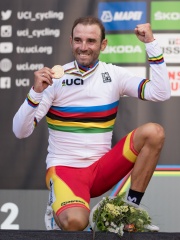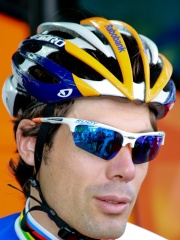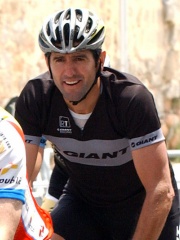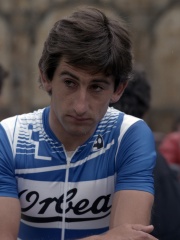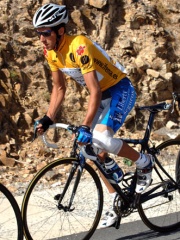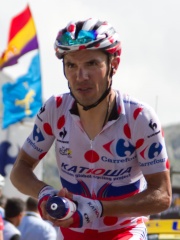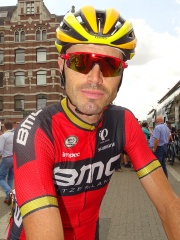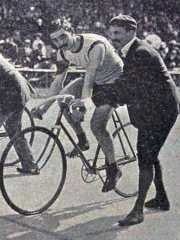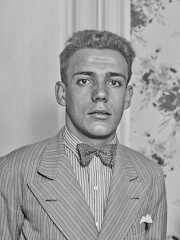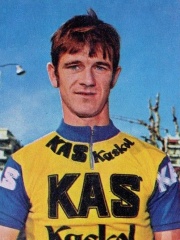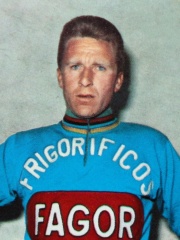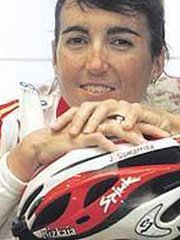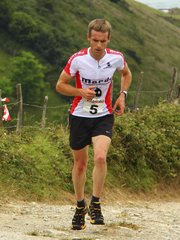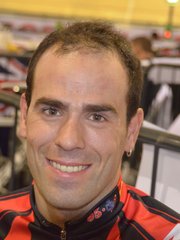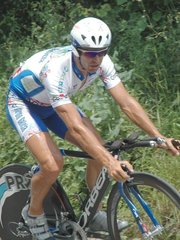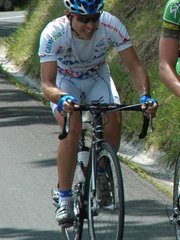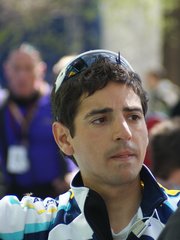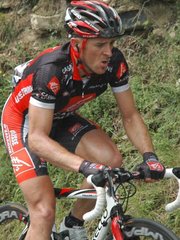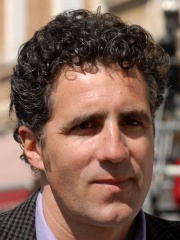
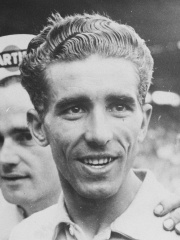
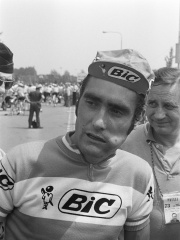
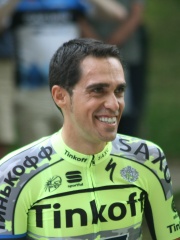
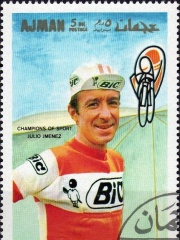
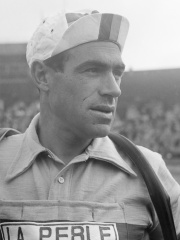
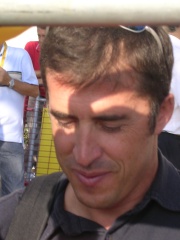
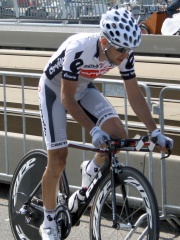
The Most Famous
CYCLISTS from Spain
Top 10
The following people are considered by Pantheon to be the top 10 most legendary Spanish Cyclists of all time. This list of famous Spanish Cyclists is sorted by HPI (Historical Popularity Index), a metric that aggregates information on a biography's online popularity. Visit the rankings page to view the entire list of Spanish Cyclists.

1. Miguel Induráin (b. 1964)
With an HPI of 66.23, Miguel Induráin is the most famous Spanish Cyclist. His biography has been translated into 59 different languages on wikipedia.
Miguel Induráin Larraya (Spanish pronunciation: [miˈɣel induˈɾajn laˈraʝa]; born 16 July 1964) is a retired Spanish road racing cyclist. Induráin won five Tours de France from 1991 to 1995, the fourth, and last, to win five times, and the only five-time winner to achieve those victories consecutively. He won the Giro d'Italia twice, becoming one of seven people to achieve the Giro-Tour double in the same season. He wore the race leader's yellow jersey in the Tour de France for 60 days. He holds the record for the most consecutive Tour de France wins and shares the record for most wins with Jacques Anquetil, Bernard Hinault and Eddy Merckx. In 1993, Indurain came close to cycling's 'Triple Crown' when, having already won the Giro and the Tour, he finished in second place just 19 seconds behind in the World Championship. Induráin's ability and physical size—186 centimetres (6 feet 1 inch) and 76 kilograms (168 pounds)—earned him the nickname "Miguelón" or "Big Mig". He was the youngest rider ever to win the Spanish amateur national road championship, when he was 18, at 20 the youngest rider to lead the Vuelta a España, and at 20 he won a stage of the Tour de l'Avenir.

2. Federico Bahamontes (1928 - 2023)
With an HPI of 65.22, Federico Bahamontes is the 2nd most famous Spanish Cyclist. His biography has been translated into 32 different languages.
Federico Martín Bahamontes, born Alejandro Martín Bahamontes (Spanish: [feðeˈɾiko maɾˈtim ba(a)ˈmontes]; 9 July 1928 – 8 August 2023), was a Spanish professional road racing cyclist. He won the 1959 Tour de France and a total of 11 Grand Tour stages between 1954 and 1965. He won a total of nine mountain classifications and was the first cyclist to complete a "career triple" by winning the mountain classification in all three Grand Tours. Following his retirement, Bahamontes ran a bicycle and motorcycle shop and was named the best climber in the history of the Tour de France by a panel organised by L'Équipe in 2013.

3. Luis Ocaña (1945 - 1994)
With an HPI of 64.95, Luis Ocaña is the 3rd most famous Spanish Cyclist. His biography has been translated into 28 different languages.
Jesús Luis Ocaña Pernía (pronounced [xeˈsus ˈlwis oˈkaɲa peɾˈnia]; 9 June 1945 – 19 May 1994) was a Spanish road bicycle racer who won the 1973 Tour de France and the 1970 Vuelta a España. During the 1971 Tour de France he launched an amazing solo breakaway that put him into the Yellow Jersey and stunned the rest of the main field, including Tour champion Eddy Merckx, but he abandoned in the fourteenth stage after a crash on the descent of the Col de Menté. Ocaña would abandon many Tours, but he finished every Vuelta a España he entered except for his first, and finished in the top 5 seven times in a row.

4. Alberto Contador (b. 1982)
With an HPI of 60.34, Alberto Contador is the 4th most famous Spanish Cyclist. His biography has been translated into 63 different languages.
Alberto Contador Velasco (Spanish pronunciation: [alˈβeɾto kontaˈðoɾ βeˈlasko]; born 6 December 1982) is a Spanish former professional cyclist. He is one of the most successful riders of his era, winning the Tour de France twice (2007, 2009), the Giro d'Italia twice (2008, 2015), and the Vuelta a España three times (2008, 2012, 2014). He is one of only seven riders to have won all three Grand Tours of cycling, and one of only two riders to have won all three more than once. He has also won the Vélo d'Or a record 4 times. He was regarded as the natural successor of Lance Armstrong and won the 2007 Tour de France with the Discovery Channel team. During his time at the Astana team, he won the 2008 Giro d'Italia, the 2008 Vuelta a España and the 2009 Tour de France. Between 2007 and 2011 he won six consecutive Grand Tours that he entered. This included winning the 2010 Tour de France with Astana, although it later emerged that he had tested positive for clenbuterol during the race. After a long battle in court, he was suspended by the Court of Arbitration for Sport and stripped of his 2010 Tour and 2011 Giro wins. Contador was known as an attacking rider who excelled as a climber, and on his best days was also an excellent time-trialist. He was also known for being able to turn races around to his favour, most notably during the Fuente Dé stage at the 2012 Vuelta a España. Following his return from suspension, he won the Vuelta twice and the Giro once more. On the penultimate day of his career, he won a stage victory at the mountaintop finish of the Alto de l'Angliru.
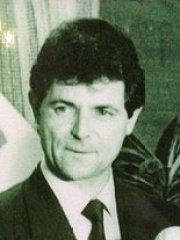
5. José Manuel Fuente (1945 - 1996)
With an HPI of 60.15, José Manuel Fuente is the 5th most famous Spanish Cyclist. His biography has been translated into 19 different languages.
José Manuel Fuente Lavandera (September 30, 1945 – July 18, 1996) was a professional road racing cyclist and noted climbing specialist. Fuente was a professional from 1970 to 1976. He had the same nickname as his father and grandfather, which was "El Tarangu", a word in the Asturian language for a man reputed for his strength and character. Fuente was known as one of the greatest climbers of his generation. He was a two-time winner of the Vuelta a España and won four consecutive climbers classification (or King of the Mountains) at the Giro d'Italia. He was rivals with the great cyclists of his time: Eddy Merckx and Luis Ocaña. He won the Vuelta a España in 1972, which at that time was held in late April and early May. Several weeks later, in the 1972 Giro d'Italia, Fuente had a great battle with Eddy Merckx. Fuente took the pink jersey as leader of the general classification early on in the race but Merckx took it back. On the mountain stage to Bardonecchia, Fuente put in an attack that put pressure on Merckx. Little by little, Merckx increased his pace and came back to Fuente and ended up winning the stage. Health problems due to kidney disease forced Fuente to retire in 1975. After retirement he opened a successful cycle business in Oviedo and in 1988 was appointed directeur sportif of the CLAS team. This lasted only a year, after which he was replaced in 1989 by Juan Fernadez. Fuente died following a long battle with kidney disease at the age of 50.

6. Julio Jiménez (1934 - 2022)
With an HPI of 59.75, Julio Jiménez is the 6th most famous Spanish Cyclist. His biography has been translated into 23 different languages.
Julio Jiménez Muñoz (28 October 1934 – 8 June 2022) was a Spanish professional road racing cyclist.

7. Bernardo Ruiz (1925 - 2025)
With an HPI of 57.73, Bernardo Ruiz is the 7th most famous Spanish Cyclist. His biography has been translated into 16 different languages.
Bernardo Ruiz Navarrete (Spanish: [beɾˈnaɾðo ˈrwiθ naβaˈrete]; 8 January 1925 – 14 August 2025) was a Spanish professional road bicycle racer who won the overall and climbers competition at the 1948 Vuelta a España. He went on to become the first Spaniard to take two wins in a single edition of the Tour de France in 1951, the first to finish on the overall podium at the Tour the following year, and the first to win a stage of the Giro d'Italia in 1955.

8. Pedro Delgado (b. 1960)
With an HPI of 57.69, Pedro Delgado is the 8th most famous Spanish Cyclist. His biography has been translated into 29 different languages.
Pedro Delgado Robledo (pronounced [ˈpeðɾo ðelˈɣaðo roˈβleðo]; born 15 April 1960), also known as Perico ([peˈɾiko]), is a Spanish former professional road bicycle racer. He won the 1988 Tour de France, as well as the Vuelta a España in 1985 and 1989. He finished in the top 10 of eighteen Grand Tours. Delgado tested positive for the known masking agent Probenecid during the 1988 tour. The drug, which had been placed on the International Olympic Committee's list of banned substances in January of that year, had not yet been banned by the sport's governing body, the Union Cycliste Internationale; as a consequence, Delgado was allowed to continue racing and was not charged with any doping offence. He now works as a sports commentator for Televisión Española during important cycling events.

9. Carlos Sastre (b. 1975)
With an HPI of 57.55, Carlos Sastre is the 9th most famous Spanish Cyclist. His biography has been translated into 47 different languages.
Carlos Sastre Candil (pronounced [ˈkaɾ.los ˈsas.tɾe ˈkandil]; born 22 April 1975) is a former Spanish professional road bicycle racer and winner of the 2008 Tour de France. He consistently achieved outstanding results in the Vuelta a España and in the Tour de France. Sastre established himself as a strong and stable climbing specialist, and after working to improve his individual time trial skills, he became a contender for the top GC spots in the Grand Tours. In total, Sastre finished in the top ten of fifteen Grand Tours during his career, and finished on the podium of each of them. Sastre never tested positive for drugs, nor was he implicated in any doping investigation, even though he performed at the top level of cycling. Sastre continues to be widely regarded, following the Lance Armstrong affair, as one of the very few 'clean' riders to have won the Tour de France in the period from 1996 to 2013, as he has never been involved in a doping affair. In fact, with respect to doping allegations and admissions that have surrounded Tour winners in recent decades, Sastre has been called "Don Limpio" ("Mr. Clean" in Spanish) by the press and others.
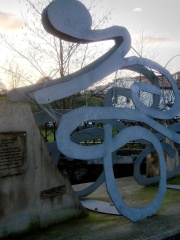
10. Vicente Trueba (1905 - 1986)
With an HPI of 57.35, Vicente Trueba is the 10th most famous Spanish Cyclist. His biography has been translated into 17 different languages.
Vicente Trueba Pérez (October 16, 1905 in Sierrapando, Torrelavega, Cantabria – November 10, 1986) was a Spanish professional road racing cyclist. He is most famous for being the first winner of King of the Mountains for winning the overall classification in the Mountains classification of Tour de France. He also finished sixth overall of Tour de France. His brother José was also a professional cyclist.
People
Pantheon has 158 people classified as Spanish cyclists born between 1881 and 2002. Of these 158, 138 (87.34%) of them are still alive today. The most famous living Spanish cyclists include Miguel Induráin, Alberto Contador, and Pedro Delgado. The most famous deceased Spanish cyclists include Federico Bahamontes, Luis Ocaña, and José Manuel Fuente. As of April 2024, 22 new Spanish cyclists have been added to Pantheon including José Antonio Escuredo, Joane Somarriba, and David Etxebarria.
Living Spanish Cyclists
Go to all RankingsMiguel Induráin
1964 - Present
HPI: 66.23
Alberto Contador
1982 - Present
HPI: 60.34
Pedro Delgado
1960 - Present
HPI: 57.69
Carlos Sastre
1975 - Present
HPI: 57.55
Alejandro Valverde
1980 - Present
HPI: 56.29
Óscar Freire
1976 - Present
HPI: 53.18
Abraham Olano
1970 - Present
HPI: 53.11
Marino Lejarreta
1957 - Present
HPI: 52.45
Óscar Pereiro
1977 - Present
HPI: 52.26
Roberto Heras
1974 - Present
HPI: 51.70
Joaquim Rodríguez
1979 - Present
HPI: 51.64
Samuel Sánchez
1978 - Present
HPI: 51.14
Deceased Spanish Cyclists
Go to all RankingsFederico Bahamontes
1928 - 2023
HPI: 65.22
Luis Ocaña
1945 - 1994
HPI: 64.95
José Manuel Fuente
1945 - 1996
HPI: 60.15
Julio Jiménez
1934 - 2022
HPI: 59.75
Bernardo Ruiz
1925 - 2025
HPI: 57.73
Vicente Trueba
1905 - 1986
HPI: 57.35
Delio Rodríguez
1916 - 1994
HPI: 57.27
Fernand Sanz
1881 - 1925
HPI: 56.67
Francisco Cepeda
1906 - 1935
HPI: 56.18
Domingo Perurena
1943 - 2023
HPI: 55.87
Emilio Rodríguez
1923 - 1984
HPI: 55.72
Francisco Gabica
1937 - 2014
HPI: 55.14
Newly Added Spanish Cyclists (2025)
Go to all RankingsJosé Antonio Escuredo
1970 - Present
HPI: 45.29
Joane Somarriba
1972 - Present
HPI: 43.39
David Etxebarria
1973 - Present
HPI: 43.25
José Enrique Gutiérrez
1974 - Present
HPI: 43.07
Carlos Torrent
1974 - Present
HPI: 43.03
Aitor Osa
1973 - Present
HPI: 42.75
Asier Maeztu
1977 - Present
HPI: 40.82
Santos González
1973 - Present
HPI: 40.49
Luis Pérez Rodríguez
1974 - Present
HPI: 40.40
Iban Mayoz
1981 - Present
HPI: 39.88
Jesús Hernández
1981 - Present
HPI: 39.66
Constantino Zaballa
1978 - Present
HPI: 39.46
Overlapping Lives
Which Cyclists were alive at the same time? This visualization shows the lifespans of the 18 most globally memorable Cyclists since 1700.

